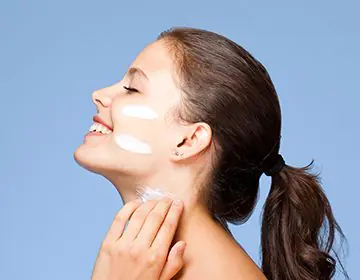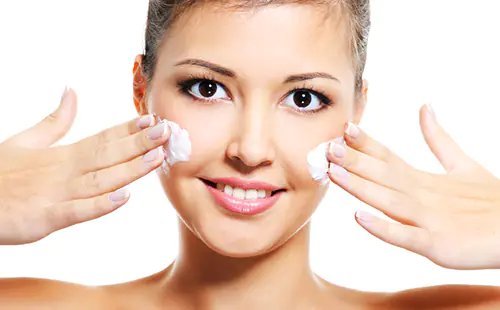Skin pigmentation is a common aesthetic problem. Nothing threatens human health; In most cases, pigment spots are not melanoma-dangerous, that is, they do not degenerate into a malignant melanoma tumor. Nevertheless, many women strive to get rid of pigmentation, especially if it appears on open areas of the body - on the face, on the back of the hands, on the neck or skin of the décolleté area.
Removal of age spots on the face is carried out using various techniques of modern cosmetology. To lighten facial skin, chemical peeling, special creams, laser resurfacing, phototherapy, biorevitalization and other techniques are used. You will learn about these and other ways to combat pigmentation, as well as the reasons for its appearance, from the proposed material.
Causes of pigmentation
There are many reasons for facial skin pigmentation. Hereditary predisposition, hormonal status of the body, taking certain medications, exposure to ultraviolet radiation, chronic pathology of internal organs, vitamin deficiency and even infectious diseases can play a role.
Despite the abundance of risk factors, the main cause of pigmentation is a combination of three reasons - skin photosensitization, local damage and ultraviolet exposure. Damage to the skin can be caused by a thermal or chemical burn, a cosmetic procedure, or an inflammatory disease. Photosensitivity is caused by many medications and cosmetics, and the source of ultraviolet radiation is a celestial body or a solarium, which has become increasingly popular in recent years.
Many patients of cosmetologists neglect the general recommendation - not to visit a solarium, not to sunbathe on the beach or in the country after cosmetic procedures. The situation is aggravated by photosensitivity, which develops while taking many medications. The following are the main groups of drugs that contribute to the development of increased sensitivity of the skin to ultraviolet radiation:
- Antibiotics: doxycycline, tetracycline, sulfonamides.
- Antifungal drugs: itraconazole, voriconazole.
- Nonsteroidal anti-inflammatory drugs: nurofen, naproxen, celecoxib.
- Diuretics: furosemide.
- Retinoids: vitamin A and its derivatives.
- Neuroleptics.
- Some medications to lower blood sugar.
Photosensitivity can result from the use of cosmetic products that contain parabens and salicylates!
The combination of ultraviolet radiation, skin damage and photosensitivity is not the only cause of the problem. Other significant risk factors include:
- Ovarian dysfunction, other hormonal disorders, in particular adrenal insufficiency.
- Changes in hormonal balance as a result of taking oral contraceptives.
- Hormone replacement therapy during menopause.
- Metabolic disorders, deficiency of certain vitamins (vitamin C, vitamin PP).
- Infectious diseases (tuberculosis, malaria, syphilis).
- Diseases of the digestive system, accompanied by impaired absorption of vitamins and microelements.
- Liver diseases.
- Systemic connective tissue diseases.
- Dermatoses: eczema, neurodermatitis, pyoderma.
It is imperative to talk about a genetic predisposition to the appearance of age spots. Blondes and red-haired people with skin phototypes 1 and 2 more often suffer from increased pigment formation. Features such as blue eyes or thin hair may indicate a predisposition to this cosmetic problem.
Dermatologists identify dozens of types of age spots. The most famous and common are lentigo, ephelides, melasma, and birthmarks. Ephelides, also known as freckles, appear on the face at a young age in people with a hereditary predisposition and fair skin. The number of freckles and the intensity of their coloring increases in the warm season, when the skin of the face is exposed to solar ultraviolet radiation.
Lentigo is a small, limited pigment spot that forms in adulthood under the influence of ultraviolet radiation. This type of lentigo is usually called solar lentigo. Senile lentigo often develops in older people. There is also juvenile lentigo, which must be differentiated from ephelides.
Secondary hyperpigmentation develops after burns, pyoderma, neurodermatitis, eczema. Sometimes age spots appear at the site of secondary syphilis rashes. There are also rarer forms of pigmentation - Broca's pigmentary dermatosis, melasma, Dubreuil's melanosis (melanoma-dangerous).
Diagnostics
It is difficult to accurately determine the type of pigmentation; this task is best entrusted to a dermatologist. Although the removal of age spots is carried out using many techniques, and the type of pigmentation does not always matter, before starting therapy, a skin biopsy is performed to confirm the benignity of the formation.
Methods for removing age spots
There are a lot of ways to combat this cosmetic defect, but not all of them are effective. Traditional recipes, such as treating the problem area of the skin with lemon juice, olive oil or celandine, often provoke irritation and inflammation, but rarely bring the desired result. It is better to use pharmaceutical products that have passed clinical trials, or seek help from a cosmetologist.
Whitening creams
A popular remedy against age spots are various whitening creams. As a rule, such a product contains hydroquinone in a concentration of 4%. It may also contain tretinoin and other retinoids. Retinoids enhance exfoliation of the epidermis, but have virtually no effect on the pigment.
Important! When using whitening products, you must protect your skin from UV exposure for three months. In countries with hot climates, you need to use a protective cream with SPF 50. For residents of Moscow and other northern regions of the Russian Federation, it is enough to apply cream with SPF 30 to the skin.
Chemical peeling
In a cosmetology clinic or aesthetic medicine center, chemical peels are often used to remove age spots. It should be said that this is far from the most progressive method of correcting the defect in question, but it can give positive results.
To combat increased pigmentation, retinoic peeling, alpha hydroxy acids, glycolic acid peeling, Jessner's combined solution (resorcinol + lactic acid + salicylic acid), trichloroacetic acid in a concentration of up to 35% are used. After the procedures, you should adhere to the above recommendation - protect the skin from UV exposure for three months. Of course, you cannot sunbathe in a solarium.
Cryotherapy
Applications of liquid nitrogen are a quick and inexpensive method of removing age spots. The procedure takes a minimum of time, since the application itself lasts about five seconds.
Injection techniques
The problem of pigmentation may be secondary, caused by a violation of the trophism of the dermis and the metabolic activity of cells. In such cases, the use of injection techniques aimed at comprehensive rejuvenation, renewal and self-healing of the skin is indicated. Plasma therapy has an excellent effect. A popular and affordable method of facial rejuvenation is biorevitalization.
Phototherapy, ELOS
Phototherapy and ELOS are similar procedures. Phototherapy is based on the action of pulsed light on the facial skin (do not confuse light with ultraviolet radiation), which destroys melanin. ELOS rejuvenation is based on a combination of electromagnetic and light radiation. ELOS technology is used not only for hair removal, but also to combat pigmentation.
Even the sun has spots. Despite all the optimism of this phrase, it does not at all reassure women who notice pigmentation on their faces. On the contrary, such dark “islands” seriously upset young ladies and force them to look for effective methods of skin whitening. Here you need to understand that the causes and treatment of age spots on the face are interconnected.

Pigmented areas that suddenly appear on the face look very unaesthetic. But this is not only a cosmetic defect. Such spots can signal the development of certain disorders in the body. Therefore, trying to get rid of pigmentation on the skin at any cost, do not forget that you need to start the fight with a visit to the doctor.
Causes and treatment of age spots on the face
The culprit behind the appearance of unsightly spots on the skin is the pigment melanin. It is capable of dyeing fabrics. Pigment is produced in the deep layers of the dermis, called basal, special cells - melanocytes. The latter not only synthesize pigment, but also ensure its active push into the upper layers.
The functioning of melanocytes and the production of melanin is controlled by important glands (thyroid) and a part of the brain (pituitary gland). Any disturbances in the functioning of the endocrine glands can lead to a malfunction, as a result of which the pigment will begin to be produced in larger quantities.
6 main causes of pigmentation
The appearance of spots on the face is dictated by increased melanin synthesis. But why does its production in the body increase? Both various pathologies and completely harmless factors may be to blame for this. Doctors indicate the following six reasons for the appearance of age spots.
- Exposure to ultraviolet radiation. The sun has quite an aggressive effect. Therefore, people who linger on the beach on a hot afternoon may instantly develop pigmented areas on their skin.
- Genetic predisposition. The hereditary factor is usually observed in fair-skinned people. Even a small portion of ultraviolet light is enough for them to cause pigmented areas to appear on the skin.
- Hormonal imbalance. The appearance of spots on the face may be due to natural processes associated with hormonal changes: puberty, pregnancy or menopause. But sometimes defects can be caused by diseases of the thyroid gland, ovaries, and pituitary gland, which also lead to impaired hormone synthesis.
- Age factor. After about age 50, some people develop pigmented spots on their skin. This is dictated by age characteristics. The dermis loses its protective function, becomes more susceptible to the aggressive effects of ultraviolet radiation, and reacts faster to any disruptions in the body.
- Mechanical damage . After acne, severe furunculosis, thermal or chemical burns, if the treatment was carried out incorrectly, pigment spots may form on the dermis. Their appearance can be caused by ill-chosen cosmetic procedures: peelings, cleansing.
- Hepatobiliary diseases. We are talking about chronic pathologies of the digestive system, liver, gall, and kidneys. Spots with a reddish tint usually characterize diseases of the gastrointestinal tract. Dark brown pigment spots indicate problems with the liver or gall bladder. And impaired kidney function makes itself felt through yellowish pigmentation.

3 rules to start treatment with
To understand how to get rid of age spots on the face, it is necessary to determine the cause of the pathology. Therefore, you cannot do without a visit to the doctor. But, regardless of the source of the problem, there are a number of rules that, if followed, will improve the condition of the dermis and the entire body.
Doctors recommend following the following three tips.
- Proper care. The dermis needs deep hydration, nutrition and quality protection. To choose the right cosmetics, it is better to consult a specialist. In the summer, before leaving the house, be sure to apply sun protection cream (SPF 30, higher if possible). Dermatologists advise wearing hats, Panama hats, and baseball caps.
- Complete nutrition. You need to enrich your diet with cereals and vegetables. Fruits, berries, and fresh herbs are good for the body. You need to give up high-protein foods, fatty and fried foods, strong tea and coffee. These foods and drinks can enhance pigmentation.
- Vitamin and mineral complexes. In winter, it is quite difficult to enrich the diet with all useful substances. Therefore, special complexes are recommended to support the body. Usually medications containing iodine, zinc, copper, iron, vitamins D, C, E are prescribed.
7 salon treatments to get rid of pigmentation
Cosmetology has an impressive arsenal of methods that allow clients to efficiently remove pigment spots on the face. The choice of procedure depends on the source of the problem, the severity of pigmentation, and the person’s age. Sometimes brownish pigment spots disappear without a trace after the first session, in other cases long-term and more serious treatment will be required.
Cosmetologists are ready to offer these seven procedures.
- Laser resurfacing. This removal of pigmentation is quite effective. Melanin under the influence of laser light wave radiation is lightened and over time the spots completely disappear. Typically, three to four procedures are required, with a one-month break between them. Laser resurfacing does not cause pain, but the sensations still depend on individual sensitivity. After the exfoliation procedure, slight redness and swelling may remain at the site of former age spots. Such consequences disappear without a trace within one week.
- Phototherapy treatment. Another effective method is to get rid of pigmented spots using a photo flash. A beam of light that does not have harmful ultraviolet radiation affects only the surface layer. Therefore, tissue damage during this procedure is minimal. Pulsed glow not only eliminates pigmentation, but also activates the production of hyaluronic acid and collagen. Thanks to this, the dermis is significantly rejuvenated. About six procedures are required to eliminate age spots. Rehabilitation does not last long and is easily tolerated.
- Cryotherapy method. The affected areas are treated with liquid nitrogen. During the procedure, the upper pigmented layer is destroyed and dies. Over the course of two weeks it peels off. Under this layer, healthy skin without any blemishes is revealed. Up to two sessions may be required.
- Chemical peeling. Depending on the type and structure of the dermis, a special acid solution is selected (usually fruit or glycolic acid). This solution “burns” the top layer of skin containing pigment spots. The epidermis, in response to such aggression, begins to actively regenerate. Renewed skin has an even, natural tone. The procedure eliminates age spots and significantly rejuvenates the dermis.
- Mesotherapy method. This method involves subcutaneous injection of bleaching substances. The most commonly used are dimethylaminoethanol and vitamin C, which ensure the restoration of the natural skin tone.
- Microdermabrasion method. This is a painful event that is performed under anesthesia. Pigmented areas are polished with tiny crystals. During this abrasive action, the top layer is peeled off, and the epidermis begins to intensively renew itself.
- Elos-method. The most gentle method for eliminating hyperpigmentation. The procedure is based on a combination of radiofrequency and laser technologies. Thanks to this combination, the Elos technique eliminates various types of stains and can be used for large areas.

Whitening cosmetics
How to remove age spots from the face without salon procedures? Cosmetologists advise paying attention to store-bought whitening products, in particular creams. Almost all manufacturers produce a series of products that eliminate pigmentation. To avoid making a mistake with your choice, it is recommended to consult a professional. And be sure to pay attention to the composition of the product you are purchasing.
A cream that has a lightening effect may contain the following components.
- Hydroquinone derivatives. These are quite toxic substances. Therefore, this cream should be used with extreme caution. Such components block the work of melanocytes, which is why they are added to cosmetics.
- Deoxyarbutin. An extract from plants that is beneficial for the dermis. It affects melanosynthesis and eliminates age spots well.
- Melanozyme derivatives. These are natural components that provide pigment lightening. They are recognized as completely safe for the dermis.
- Provitamin A. This is a well-known, very strong antioxidant. This component inhibits the production of melanin.
- Acids. Citric, malic or acetic acids have a brightening effect on the skin.
- Tretinol. The substance resembles vitamin A in action. It ensures collagen synthesis and improves skin structure. But sometimes tretinol can provoke peeling and cause irritation on the dermis.
6 home remedies
You can remove age spots on your face not only with the help of salon treatments or whitening creams. Homemade masks, lotions and compresses can lighten darkened areas of the skin. The following folk remedies cope effectively with this task.

The power of parsley
- Parsley root (chopped) - one teaspoon.
- Parsley (ground) - one teaspoon.
- The washed and dried root of the plant is crushed in a blender.
- The greens are ground.
- The crushed root is combined with green gruel and mixed.
- The parsley mixture is applied to age spots for 25-30 minutes.
- Such sessions are allowed to be repeated daily.

Yeast clarification
- Yeast (live) - 15 g.
- Lemon juice - one teaspoon.
- Water - one teaspoon.
- It is better to use live yeast. But if you couldn’t purchase them, you can use dry ones. Yeast is kneaded in a bowl.
- Lemon juice is diluted with warm water.
- Pour the diluted drink into the yeast and stir the mixture.
- The yeast mask is applied to age spots for half an hour.
Curd white
- Cottage cheese - one tablespoon.
- Ammonia - ten drops.
- Hydrogen peroxide - ten drops.
- The cottage cheese is ground until a homogeneous mixture is obtained.
- Ammonia and peroxide are added to the product.
- Mix the mask thoroughly.
- Apply the product to pigmented areas for a quarter of an hour.

The luxury of black currants with honey
- Black currants (unripe berries) - two tablespoons.
- Honey - two tablespoons.
- To combat age spots, it is recommended to use slightly unripe berries. Black currants are carefully ground in a mortar or by hand.
- Add honey to the greenish-black mixture and knead the mask.
- Apply the product generously to dark areas of the dermis. Wash off the mask after half an hour.

With fish oil and honey
- Honey - one tablespoon
- Fish oil - one tablespoon.
- Honey is added to fish oil. The product is thoroughly mixed.
- Apply the mask to the face for 20 minutes.

According to Cleopatra's method
- Sour cream - one teaspoon.
- White clay - one teaspoon.
- Honey - one teaspoon.
- Lemon juice - one teaspoon.
- White clay is poured into a non-metallic bowl. The powder is diluted with lemon juice.
- Sour cream is added to the mixture and honey is added. The product is thoroughly mixed.
- The mask is applied to the skin for 20 minutes.
- After this, the products must moisturize the dermis, since clay and lemon juice provide a pronounced drying effect.
Knowing how to remove age spots on your face, you can always look great. But if pigmentation on the skin appears suddenly, then pay special attention to such spots. The danger is represented by overly pronounced dark areas with spots that have uneven borders and thickened edges. Sometimes they can indicate the development of malignant tumors. Therefore, do not rush to put all your knowledge into practice until you eliminate the risk of serious pathologies.

“I tried everything, but castor oil helped,” - reviews and personal experience in dealing with pigmentation
About a year and a half ago, I developed a pigment spot. Moreover, I think that the sun has nothing to do with it (firstly, the spot is under the bangs, and secondly, I am extremely rarely in the sun). I recently completed two Elos rejuvenation sessions. The cosmetologist, using a more powerful mode than on the entire face, “walked” over the spot. Now it’s practically invisible, although I didn’t even set such a goal. I also have spider veins, they worried me more... and they disappeared by 80%.
Olesya V., //www.woman.ru/beauty/face/thread/3873852/2/
Girls, my mother reduced age spots with lemon. They also remained after pregnancy. But she applied it almost every day and now she applies it, she already has this procedure automatic. There have been no spots for a long time, although I have it constantly in the sun, because... lives in his own house. Besides, she doesn’t use sunscreen... I started trying, I also had this problem after pregnancy, I’m waiting for the effect.
I remove pigment spots in the salon with a flash. The spots darken, become crusty, and then disappear. I even sunbathe often, new ones appear, but in different places.
As for stains, I can say one thing - everything can be treated successfully! Especially if it is purchased. I got spots as a result of peeling on my face (something like bodyagi). I cried over my face for 3 years, I tried EVERYTHING! And I can say - yes, castor oil has been providing better and better complexion for the past 2 months, the spots are gradually disappearing. I think I'll bring everything to perfection. And I'm looking forward to a summer tan.
Content
Pigment spots appearing on the face are a modern problem for many women. And this is not surprising, because they can ruin the appearance of any person, regardless of age and self-care. Chloasma or age spots on the body and face are small crumbly neoplasms of a brown or reddish hue that form on the skin as a result of the accumulation of melanin in its upper layer. There may be many reasons for this, but it is quite difficult to remove such tumors - often the procedure is carried out in a salon under the supervision of a cosmetologist.
Pigment spots, fortunately, do not cause harm or danger to the skin, and even less so to humans. But still, their presence on the face can upset anyone, so it is important to get rid of tumors in time before they “fill up” the entire base of the face.
Causes of pigmentation
Pigment spots appearing on the face are a problem for mature women, since it is after 40 years that they begin to actively manifest themselves. However, not only mature ladies suffer from them - pigmentation on the face and body often appears in young girls.
There are many reasons for this - the most common of them are:
- disorders of the adrenal glands;
- constant contact with dyes;
- chemical effects on the body;
- lack of vitamin B3;
- long exposure to the sun;
- early aging and aging of the skin;
- taking hormonal drugs and contraceptives;
- diseases of the genital organs;
- a sharp change in hormonal levels during pregnancy;
- use of unnatural cosmetics.
If age spots on the face appear for this reason, they can be removed by a cosmetologist using certain procedures. The fact is that in medical centers and salons there are a lot of procedures for removing pigmentation.
Methods for removing pigmentation with the help of a cosmetologist
In a professional and modern salon, the doctor will offer several types of skin whitening, which will depend on the nature of the tumor and the speed of its spread.
Important: specially developed techniques will be effective only if the cause of pigmentation is known - otherwise spots on the face will appear in the near future. It is also important for the doctor to know the depth of the pigment in order to perform the procedure in one go without causing harm to the upper layer of the skin.
Cosmetology offers women to use a laser that does not damage the top layer of skin, while affecting all damaged areas. Also, this method does not harm the inner layer of the skin and does not destroy its composition.
Thanks to the laser, it is possible to destroy melanin cells in just one procedure, especially if they are located on the surface of the epithelium. Also, if the cosmetologist works correctly, the laser will help restore skin tone and stimulate collagen production, which is important when completing the procedure.
Phototherapy, which is carried out with the help of a cosmetologist, has a positive effect immediately after the procedure. Photowaves act on skin tissue using pulsed light, without destroying the epithelium. Phototherapy destroys melanin cells in just a few minutes without causing pain or discomfort.
After the procedure, the spots on the face darken significantly, and then after a certain time the skin begins to peel off and lighten. In total, the patient is recommended to undergo 3-5 procedures to completely get rid of tumors and prevent their reappearance.
Cosmetology contains many methods for removing pigmentation. The most effective and affordable is peeling, which not only removes tumors, but also evens out the color and structure of the skin, cleanses the top layer and produces collagen.
This peeling is applied to the entire base of the face. Its composition and exposure time depend on the location of melanin, which can be in both the upper and inner layers of the skin.
In addition to removing pigmentation, this method allows you to cope with other facial skin problems. To completely remove the tumor, a woman will need 2-4 procedures, which are carried out under the supervision of a cosmetologist.
Whitening mesotherapy helps to quickly remove pigmentation using a special cocktail. During this procedure, hyaluronic acid is injected, which is used to whiten the skin. In addition to quickly eliminating tumors, this method allows you to rejuvenate your face. However, according to cosmetologists, this method is less fast and effective than laser therapy.
The cocktail may also contain vitamins that can saturate the epithelium with useful substances.
If you do not want to see pigment spots on your face, you can avoid their appearance by doing the following:
- do not use creams that dry out the skin;
- reduce coffee intake;
- consume only natural products containing vitamins and microelements;
- protect your facial skin from the sun.
This is the only way to prevent the appearance of pigmentation and keep the skin young and healthy. The main thing for this is to maintain proper hygiene and immediately take action after detecting unpleasant rashes.



